A consulting business model is the repeatable recipe a firm uses to turn expertise into steady cash. It does this by solving one costly client problem, packaging a signature solution, and pricing it so both value and profit grow together.
–
For the 4 consulting business models, go here.
For the self-assessment scorecard to know which model to pick, jump to this section.
For the 6 components of a successful consulting business, click here.
–
The 4 Consulting Business Models
I’ve watched consultants either thrive or struggle for years. The difference isn’t talent or connections. It’s picking the right business model for your personality and market.
Most consultants stumble into whatever feels natural without thinking strategically. They wonder why their income feels like a rollercoaster ride. Stop the guessing game.
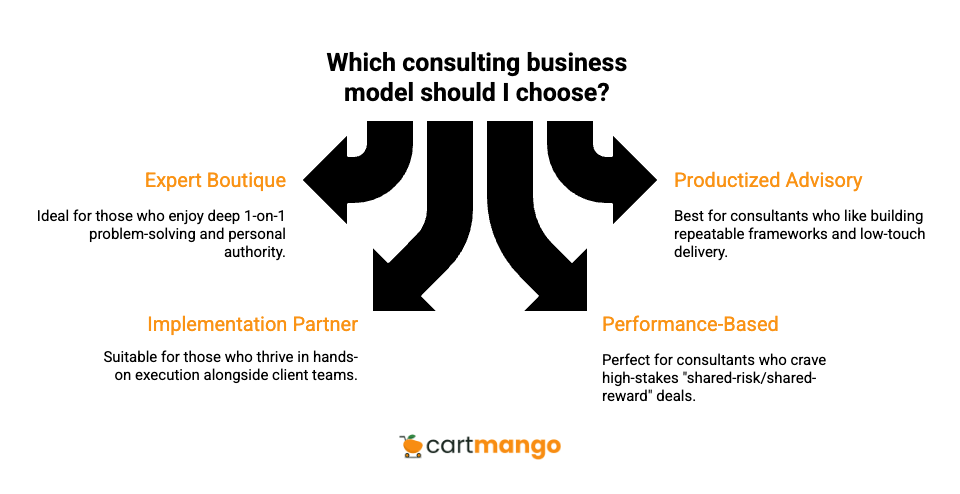
Consulting Business Model Comparison
Business Model | Fits Best If You… | Execution Level | Common Pitfall |
|---|---|---|---|
Expert Boutique | Love deep 1-on-1 problem-solving & personal authority | Mostly advisory, occasional hands-on help | Founder bottleneck |
Productized Advisory | Enjoy building repeatable frameworks & low-touch delivery | Advisory first, delivered via standardized playbooks | Over-standardization |
Implementation Partner | Thrive in hands-on execution alongside client teams | Full “build-and-deploy” delivery start to finish | Staff churn |
Performance-Based | Crave high-stakes “shared-risk/shared-reward” deals | Co-execute closely until outcomes trigger success fees | Cash-flow lag |
Consulting Business Model #1: Expert Boutique
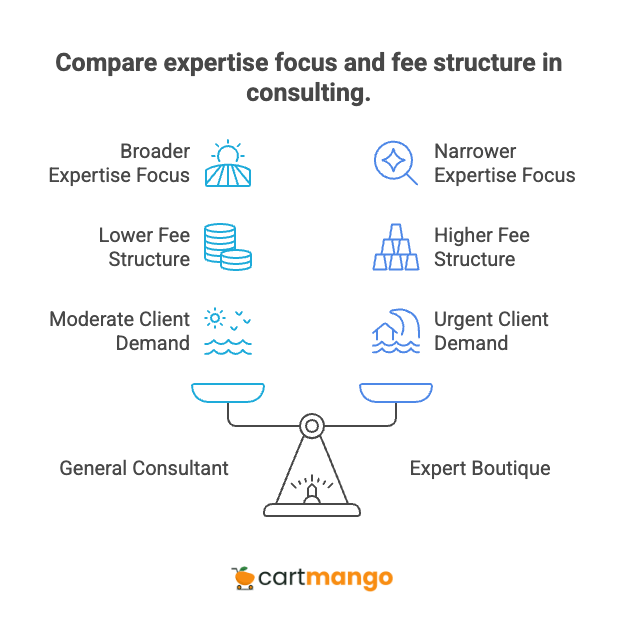
You sell your brain, not your hands.
Clients pay premium rates because you see patterns they miss completely. Your typical engagement involves diagnosis, strategy design, and high-level guidance while their team handles execution.
The money flows from being the go-to person for specific crises. Maybe you fix broken sales teams hemorrhaging revenue. Maybe you rescue product launches about to crash spectacularly. The narrower your expertise, the higher your fees climb.
A consultant who exclusively fixes manufacturing quality disasters can charge tens of thousands of dollars because when production lines shut down, every minute costs clients thousands in lost revenue. His phone rings constantly with urgent requests from desperate plant managers.
This model works because of the expertise premium. You’re not competing on price or availability. You’re competing on results and specialized knowledge that can’t be easily replicated or commoditized.
Revenue streams typically include high-value diagnostic engagements ($15,000-50,000), strategic planning projects ($25,000-100,000), and ongoing advisory retainers ($5,000-25,000 monthly). The key is positioning yourself as irreplaceable expertise rather than extra capacity.
Client relationships tend to be intense but shorter-term. You solve the crisis, transfer knowledge, and move on. Repeat business comes from new crises or referrals to similar companies facing identical problems.
The execution level stays mostly advisory with selective hands-on intervention. You might attend crucial board meetings, review critical documents, or coach senior leaders through tough decisions. But the bulk of implementation happens through their people, guided by your strategic direction and expertise.
Consulting Business Model #2: Productized Advisory
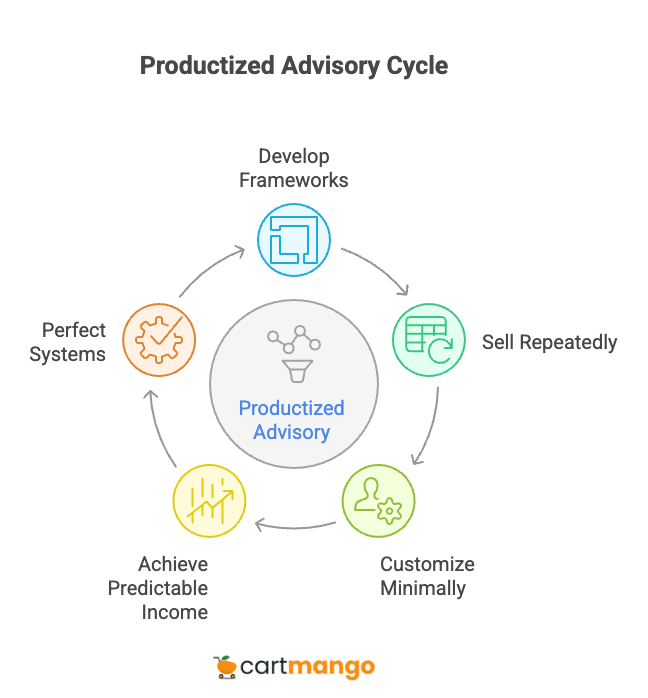
You build systems once and sell them repeatedly with minor modifications.
Think consulting meets software development. You create frameworks, templates, and processes that work for multiple clients with minimal customization required.
Your income becomes predictable because you’re not reinventing solutions constantly. The sweet spot involves finding problems affecting many companies in remarkably similar ways. Customer onboarding disasters, employee retention failures, data migration nightmares, or compliance audit preparations.
This model can drive you absolutely crazy if you love variety and custom work. But if you enjoy perfecting systems and seeing consistent results across different organizations, it pays exceptionally well.
Revenue streams include standardized assessments ($5,000-15,000), implementation packages ($20,000-75,000), and subscription access to tools and frameworks ($500-5,000 monthly). The beauty lies in economies of scale and reduced delivery costs over time.
Your execution stays advisory-first but gets delivered through standardized playbooks and materials. You might offer a 30-day marketing audit that follows identical steps every time. Or a leadership development program with predetermined modules and materials that work across industries.
The predictability factor cannot be overstated. Clients know exactly what they’re buying upfront. You know precisely what you’re delivering and how long it takes. Sales cycles shorten dramatically because there’s less customization to negotiate and scope.
Client relationships become more transactional but also more scalable. You can serve more clients simultaneously because each engagement follows proven patterns. Repeat business comes from annual assessments, updates to your methodology, or expansion to other departments.
Consulting Business Model #3: Implementation Partner
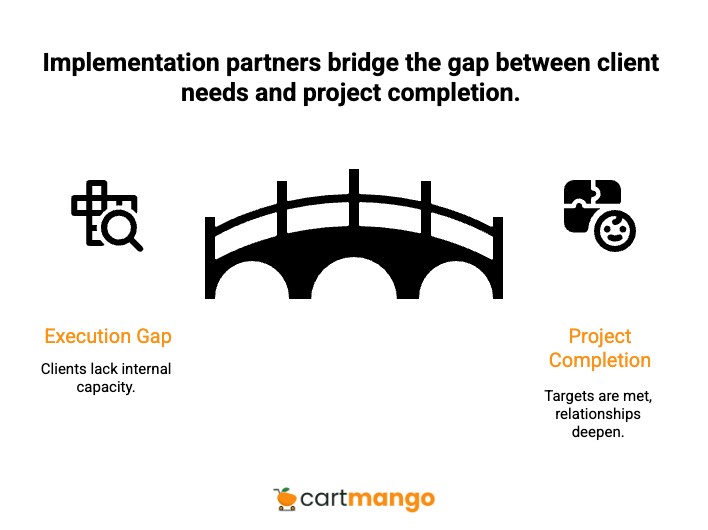
You roll up your sleeves and get dirty with actual work.
While other consultants write elegant reports and disappear into the sunset, you stay until the job gets completely finished. You configure software systems, train entire teams, manage organizational change initiatives, and measure results until targets are met.
This model works exceptionally well when clients lack internal capacity or specialized expertise. They understand what needs happening but can’t execute alone effectively. Your team becomes an extension of theirs for months or even years.
The downside hits hard when project overruns start melting away your margins like ice cream in summer. The upside creates deep client relationships and recurring work opportunities. Many implementation partners see 70-80 percent of their revenue flowing from existing clients year after year.
Revenue streams include project-based contracts ($50,000-500,000), time-and-materials billing ($150-300 per hour for team members), and milestone-based payments tied to deliverable completion. Cash flow tends to be lumpy but substantial when projects complete successfully.
Your execution level requires full “build-and-deploy” capability from initial design through final deployment and user adoption. You might design the solution architecture, configure the technology stack, train end users, and stick around until adoption hits target levels consistently.
Client relationships become partnerships rather than vendor arrangements. You’re invested in their success because your reputation depends on working solutions, not just good advice. These relationships often span multiple years and projects.
The complexity factor cannot be ignored. You need project management skills, technical expertise, change management capabilities, and the ability to coordinate multiple stakeholders across different organizations. Many implementation partners burn out from the intensity and complexity.
Consulting Business Model #4: Performance-Based
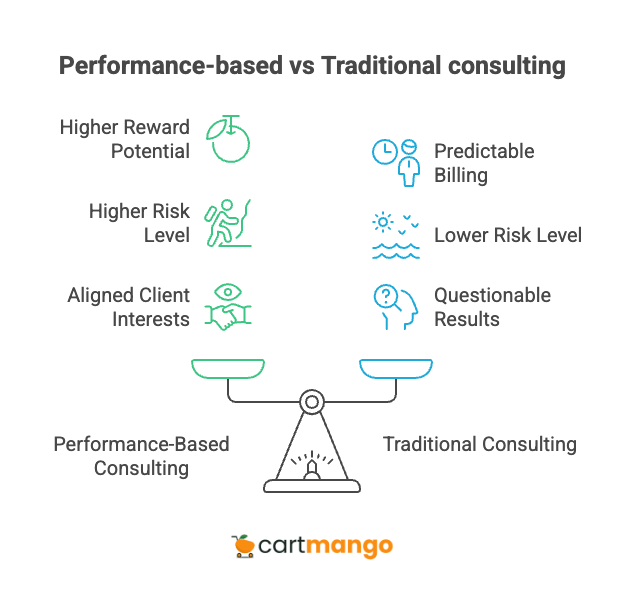
Your paycheck depends entirely on their measurable results.
Instead of billing hours like lawyers, you capture a percentage of the value you create directly. Higher risk leads to higher reward potential, but the stakes are real.
This model attracts clients who’ve been burned by traditional consulting approaches. They’ve watched firms charge massive fees while delivering questionable results that never got implemented. With performance-based pricing, your interests align perfectly with theirs.
The cash flow challenge can be brutal, especially in the beginning. You might work for months before seeing significant payment. But when you nail the outcome, the payday can be absolutely life-changing. I’ve watched performance-based consultants earn seven figures from single engagements.
Revenue streams are entirely outcome-dependent: percentage of cost savings (10-30%), revenue improvement shares (5-15%), or fixed success fees tied to specific milestones ($25,000-1,000,000+). The variability is extreme but so is the upside potential.
Your execution requires co-executing closely with the client until outcomes trigger your success fee payments. You can’t just provide advice and hope they implement well. Your compensation depends on measurable, verifiable results that you help create and sustain.
This means building bulletproof measurement systems, staying deeply involved throughout implementation, and sometimes making tough decisions about scope or timeline to protect the outcome you’re betting on financially.
Client relationships become true partnerships with shared risk and reward. When they win, you win big. When they struggle, you work for free until problems get resolved. These relationships often become long-term because success breeds more opportunities.
Find Your Natural Fit
This quick exercise saves weeks of second-guessing and helps you commit to a model that fits both your personality and your market.
Question (Yes/No) | Boutique | Productized | Implementation | Performance |
|---|---|---|---|---|
Prefer deep expertise over breadth? | +1 | 0 | 0 | 0 |
Enjoy building systems once & re-using them? | 0 | +1 | 0 | 0 |
Energized by rolling up sleeves to co-execute? | 0 | 0 | +1 | 0 |
Does a risk-reward gamble motivate you? | 0 | 0 | 0 | +1 |
Comfortable marketing via thought-leadership? | +1 | +1 | 0 | 0 |
Can you staff & manage multi-month delivery teams? | 0 | 0 | +1 | +1 |
Prefer recurring revenue over one-offs? | 0 | +1 | 0 | +1 |
- Mark “Yes” or “No” for each row.
- Add points in every “Yes” column.
- The highest column reveals your natural fit.
Here’s how this works in practice with an example:
Scorecard Interpretation Guide
If Expert Boutique wins (4+ points): You thrive on being the smartest person in the room solving complex problems that require deep expertise. Focus on building your personal brand and thought leadership. Charge premium rates for your insights and strategic guidance.
If Productized Advisory wins (4+ points): You love creating systems that work repeatedly with minimal customization. Focus on identifying common problems across your target market and building standardized solutions. Scale through processes, not people.
If Implementation Partner wins (4+ points): You enjoy the satisfaction of seeing solutions actually work in practice. Focus on building strong project management capabilities and hiring skilled execution teams. Success comes from delivering results, not just recommendations.
If Performance-Based wins (4+ points): You’re comfortable with income variability in exchange for unlimited upside potential. Focus on developing bulletproof measurement systems and choosing clients with significant improvement potential. Your success depends entirely on their success.
–
Scorecard Filled-In Example
Question | Answer | Boutique | Productized | Implementation | Performance |
|---|---|---|---|---|---|
Prefer deep expertise over breadth? | Yes | +1 | 0 | 0 | 0 |
Enjoy building systems once & re-using them? | No | 0 | 0 | 0 | 0 |
Energized by rolling up sleeves to co-execute? | Yes | 0 | 0 | +1 | 0 |
Does a risk-reward gamble motivate you? | No | 0 | 0 | 0 | 0 |
Comfortable marketing via thought-leadership? | Yes | +1 | +1 | 0 | 0 |
Can you staff & manage multi-month delivery teams? | Yes | 0 | 0 | +1 | +1 |
Prefer recurring revenue over one-offs? | Yes | 0 | +1 | 0 | +1 |
Totals | 2 | 2 | 2 | 2 |
When Scores Tie
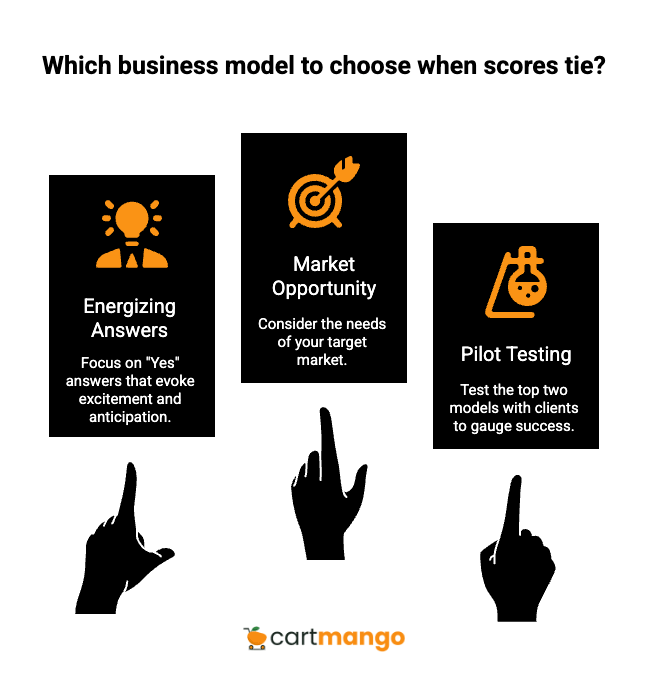
When this happens, focus on the “Yes” answers that genuinely excite you most. Which ones make you lean forward with anticipation?
Consider your target market too. If you serve fast-growing SaaS companies, a Productized Advisory model often wins because those clients need proven frameworks they can implement rapidly.
- Look at which “Yes” answers feel most energizing day-to-day. Do you get more excited about building repeatable systems or diving deep into complex problems?
- Re-rank tied models by market opportunity in your niche. SaaS startups often favor Productized Advisory, while manufacturing companies might need Implementation Partners.
- Pilot the top two models with 1-3 clients each. Track your energy levels, profit margins, and client satisfaction. The clear winner becomes your focus.
6 Core Components of Thriving Consulting Businesses
Every successful consulting model rests on 6 fundamental pillars.
Miss even one and your business becomes a house of cards ready to collapse at the first strong wind. Get all 6 right and you’ve built something that generates revenue without your constant personal involvement.
1/ Ideal Client + Burning Pain
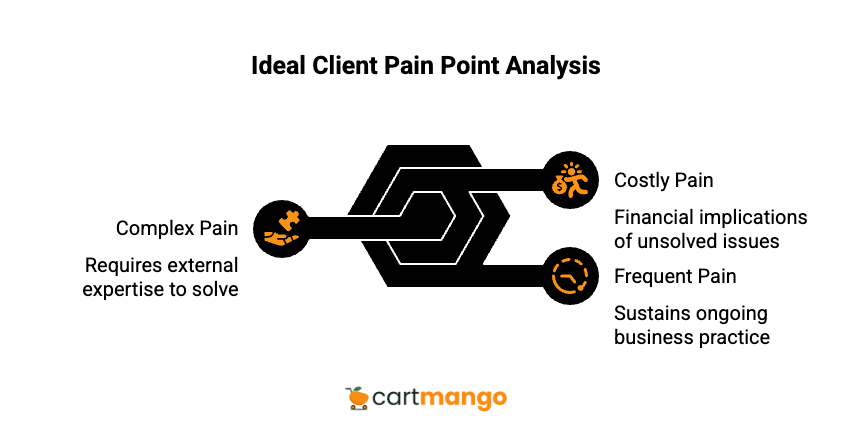
Most consultants target “small to medium businesses” or “companies needing strategy help.”
That’s like saying you help “people with problems.” Be ruthlessly specific about who you serve and what keeps them awake at night.
Your ideal client should be easy to find, easy to reach, and desperately need what you offer. The pain should be urgent enough that they’ll pay premium rates to fix it quickly rather than suffering through it longer.
The pain point needs 3 characteristics working together:
- costly when left unsolved
- frequent enough to build a sustainable practice around
- complex enough that they can’t fix it alone with internal resources
Start by interviewing your best current and former clients. What specific problems brought them to you originally? What was it costing them to leave those problems unsolved? How had they tried to fix it before calling you?
Look for recurring patterns in their responses. Maybe they all struggled with the same type of operational inefficiency that was bleeding cash daily. Maybe they all faced similar regulatory compliance challenges with severe penalty risks.
Write this down as a one-sentence pain statement:
“I help [specific type of company] solve [specific costly problem] that is currently costing them [specific measurable consequence].”
For example:
“I help family-owned manufacturing companies with 50-200 employees solve succession planning crises that threaten to destroy generations of family wealth within the next five years.”
Pain Research Process:
- Interview 15+ current/former clients
- Identify patterns in their responses
- Rank problems by cost, frequency, difficulty
- Write one-sentence pain statements for top 3
- Test messaging with prospects
- Refine based on market response
–
2/ Signature Framework
You need a methodology that’s uniquely yours and immediately recognizable. Not just “we do strategy consulting” or “we help with digital transformation.” A specific, step-by-step process that clients can visualize and understand completely.
The best frameworks contain three to five phases with crystal-clear deliverables.
Example:
- Phase 1: Current State Assessment
- Phase 2: Future State Design
- Phase 3: Implementation Roadmap
Simple enough for a CEO to explain confidently to their board of directors.
Your framework becomes your professional calling card. It appears in proposals, case studies, conference presentations, and referral conversations. It’s what people remember and reference when describing your approach to others.
Think carefully about how you actually solve your clients’ problems in practice. What’s your mental checklist? What questions do you always ask first? What deliverables do you always create? What sequence do you follow naturally?
Document this as a visual process map showing clear connections between phases. Use boxes and arrows to demonstrate how one phase leads logically to the next. Include key activities, deliverables, and decision points throughout.
Give your framework a memorable name that captures the transformation you deliver.
“The Revenue Recovery Method.” “The Leadership Alignment Process.” “The Digital Transformation Blueprint.” Something clients can easily remember and reference in conversations.
Framework Development Steps:
- Map your current problem-solving process
- Identify 3-5 logical phases
- Define deliverables for each phase
- Create visual representation
- Name your methodology
- Test with pilot clients
- Refine based on feedback
–
3/ Pricing
This is where most consultants leave enormous amounts of money on the table. They charge by the hour like taxi drivers instead of pricing based on the value they deliver to clients.
Four main approaches work effectively in practice:
- Value-based pricing (percentage of value created)
- Retainer pricing (monthly fee for ongoing access)
- Performance pricing (success fees tied to outcomes)
- Subscription pricing (recurring fee for continuous service access)
The right choice depends on your business model and target market dynamics. Expert boutiques often use value-based project pricing. Productized advisory firms love subscription models. Performance-based firms obviously use success fee structures.
Value-based pricing requires deep understanding of your client’s economic situation. If fixing their sales process could generate $500,000 in additional annual revenue, a $50,000 consulting fee is a 10x return on investment.
Retainer pricing works when clients need ongoing access to your expertise for strategic questions, market insights, or crisis response situations. They pay a monthly fee to have you available when needed.
Performance pricing ties your compensation directly to measurable outcomes you help achieve. You might capture 15-20 percent of cost savings you generate or revenue improvements you drive. Higher risk but unlimited upside potential.
Pricing Selection:
- Expert Boutique: Value-based project fees ($25K-$200K)
- Productized Advisory: Subscription models ($500-$5K monthly)
- Implementation Partner: Milestone-based pricing ($50K-$500K)
- Performance-Based: Success fees (10-30% of impact)
Start with simple pricing structures and evolve toward more sophisticated approaches over time. Fixed-price projects work better than hourly billing for most situations. Value-based pricing works better than fixed prices when you can measure outcomes clearly.
–
4/ Delivery
How does the actual work get completed?
Are you primarily an advisor who guides client teams? Do you provide “done-with-you” support where you work alongside their people? Or do you handle full implementation yourself?
This choice shapes everything else about your business: profit margins, team requirements, client relationships, project complexity, and growth potential. Each approach has distinct advantages and trade-offs you need to understand.
Advisory delivery means you diagnose problems, design solutions, and transfer knowledge to client teams who handle execution. Your role focuses on strategic guidance and expertise transfer while they provide implementation capacity.
“Done-with-you” delivery means working alongside client teams throughout the implementation process. You might lead key workstreams while they handle others. You provide expertise and project management while they contribute industry knowledge and organizational context.
Full implementation means you handle everything from initial design through final deployment and user training. Clients receive working solutions but pay higher fees and wait longer for results. This model requires the most internal capacity but can generate the highest margins.
Delivery Models:
- Advisory: Higher margins, requires strong client teams
- Done-with-you: Balanced risk, shared accountability
- Full implementation: Higher revenue, resource intensive
–
5/ Lead Generation
You need a systematic approach that generates qualified prospects consistently, not just when you remember to do business development activities. The best consulting firms rely on three primary sources working together.
Referrals from existing clients should drive some of your pipeline if you’re consistently delivering excellent results. But you can’t rely on referrals alone because they’re unpredictable and outside your direct control.
Authority content marketing builds your professional reputation and attracts inbound leads who already understand your value proposition before they contact you. Blog posts, LinkedIn content, speaking engagements, and podcast interviews all contribute.
Strategic partnerships with complementary professional services firms create win-win referral opportunities. Accounting firms, law firms, technology vendors, and other consultants often need reliable partners for their clients.
Lead Generation by Model:
- Expert Boutique: Thought leadership + speaking + referrals
- Productized Advisory: Content marketing + webinars + partnerships
- Implementation Partner: Case studies + partner networks + referrals
- Performance-Based: Results stories + industry events + referrals
–
6/ Talent Structure
Talent Structure | How It Works | When It Shines | Watch-Out |
|---|---|---|---|
Solo Operator | You deliver all work | Early stages; niche expertise | Revenue ceiling tied to your hours |
Pod Model | Small team per engagement | Mid-size projects with varied skills | Needs strong SOPs |
On-Demand Network | Freelancers per project | Variable workloads | Coordination overhead |
Solo works when your personal expertise is the primary value driver. Revenue depends entirely on your capacity.
Pods scale better because you’re not the bottleneck for every decision. Small teams handle complete engagements while you focus on strategy and relationships.
Networks offer tremendous flexibility for variable workloads. Assemble teams based on project needs. You only pay for resources actually used. But coordination complexity increases substantially.
Standard operating procedures become absolutely critical as you move beyond solo work. Document how you kick off engagements, what information you collect, how you present recommendations, what quality deliverables look like.
Actually Building Your Consulting Model
Now that you understand the 6 core components of a consulting business, it’s now time to put them into practice.
Step 1: Rank Client Pains by Upside
List every significant problem your ideal clients face regularly. Focus on painful, expensive, urgent problems that keep senior executives awake at night staring at the ceiling.
Rank each problem by three specific criteria:
- Cost impact (1-10)
- Frequency in your market (1-10)
- Difficulty to solve alone (1-10).
Multiply scores for total ranking. Problems scoring 500+ deserve serious consideration.
Interview 10-15 current clients about what brought them to you originally. Document patterns and create detailed pain profiles with specific cost examples.
–
Step 2: Package Your Signature Framework
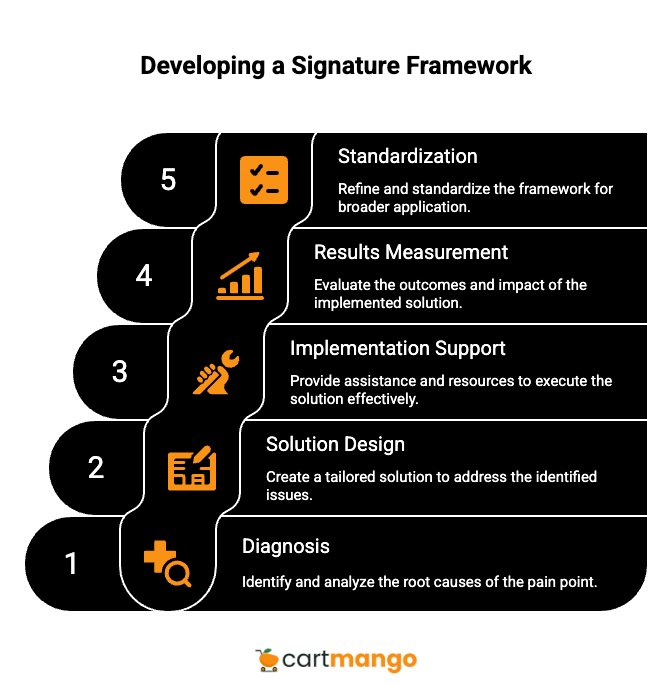
Design a systematic approach to solve your highest-ranking pain. We talked about the 3-phase framework above.
- Diagnosis and root cause analysis
- Solution design
- Implementation support and results measurement
Write this as a one-page document with clear visuals. Give it a memorable name that captures the outcome. Test thoroughly with pilot clients before standardizing.
–
Step 3: Choose Your Pricing Model
Estimate the total economic impact of solving their problem completely. Value-based pricing should capture 10-20 percent of the value created. Performance pricing might take 15-30 percent of measurable improvements.
Document your pricing rationale clearly so you can explain it confidently during sales conversations.
–
Step 4: Build an Evergreen Funnel
Create a lead magnet that solves a smaller version of your main problem. Design diagnostic calls that qualify prospects while providing genuine value. Write proposals that connect their situation to your systematic approach.
Track conversion rates at each stage and optimize the lowest-performing elements first.
–
Step 5: Systematize Delivery with SOPs
Document every recurring process: client onboarding, discovery calls, deliverable creation, quality review, project closeout. Start simple with checklists and evolve toward comprehensive training materials.
Browse Notion’s Operations Templates to get started fast.
–
Step 6: Review Metrics Quarterly
Track lead volume, win rate, and gross margin monthly. Review trends quarterly and identify constraints. Use data to guide strategic decisions about hiring, pricing, and market focus.
Pitfalls of Consulting Businesses
Pitfall 1: Custom Everything
The 70/20/10 rule prevents this trap: 70% standard framework, 20% industry customization, 10% unique elements. This maintains quality while building efficiency.
Pitfall 2: Under-Pricing
Price based on client upside, not your costs. Senior consultants should charge for outcomes and insights, not time. Premium pricing attracts better clients who value results.
Pitfall 3: Delivery Bottleneck
Hire execution teams before you feel ready. Start delegating research and analysis while keeping strategy and client relationships. Your job changes from doing work to ensuring quality.
Considerations for Consulting Excellence
Financial Management and Sustainable Operations
Sound financial management separates thriving consulting practices from those that struggle. Whether you’re independent consultants building solo consulting careers or business consulting firms scaling operations, mastering cash flow and expense control drives sustainable growth and long term success.
Business owners running boutique consulting firms face unique challenges compared to solo consultants or independent contractors. Your firm model must balance profitability with service quality while adapting to shifting market trends and emerging trends in the consulting industry.
Navigating Industry Evolution and Client Demands
The consulting industry continues evolving rapidly. Successful consulting business leaders stay ahead by monitoring industry trends and leveraging market data to refine their consulting services. Client expectations have shifted dramatically, demanding more strategic advice, specialized services, and measurable outcomes.
Data analytics and digital tools now enable even small boutique consultancies to compete effectively. These technologies enhance service delivery, improve operational efficiency, and help consultants deliver superior client communication and customized solutions to potential clients.
Building Your Ideal Business Framework
Finding your ideal consulting business model requires honest self assessment of your personal interests, previous job experience, and long-term goals. The best consulting business model aligns with your strengths while serving market demand.
As I said above, some consulting practices adopt a hybrid model combining productized consulting with traditional project-based work. This approach balances the scalability of a productized model with the flexibility needed for one off projects and complex client engagements.
Scaling Through People and Processes
Business growth often requires expanding beyond solo consulting. Developing robust training programs for junior consultants and managing external consultants becomes crucial for maintaining quality as you scale your consulting practice.
Protecting intellectual property and systematizing service offerings enables consistent service delivery regardless of who handles specific client delivery tasks. This systematic approach helps when consultants jump between different types of engagements or when managing multiple client data sources simultaneously.
Leveraging Technology and Market Intelligence
Modern consulting services increasingly rely on sophisticated data analytics to provide competitive advantage. Combining client data with broader market data helps consultants deliver more insightful strategic advice and better anticipate client needs.
The project model must accommodate both traditional consulting approaches and emerging digital-first methodologies. Business consulting today requires fluency with digital tools while maintaining the human touch that defines successful client relationships.
Achieving Sustainability
Continuous improvement in your service offerings and operational efficiency creates compounding returns over time. Whether operating as independent contractors or building larger business consulting firms, focus on systems that support both immediate client success and long-term business success.
The most successful consulting business leaders understand that sustainable growth comes from aligning market trends with their unique capabilities, then building scalable systems around that intersection.
Your Next Steps: Take Action Today
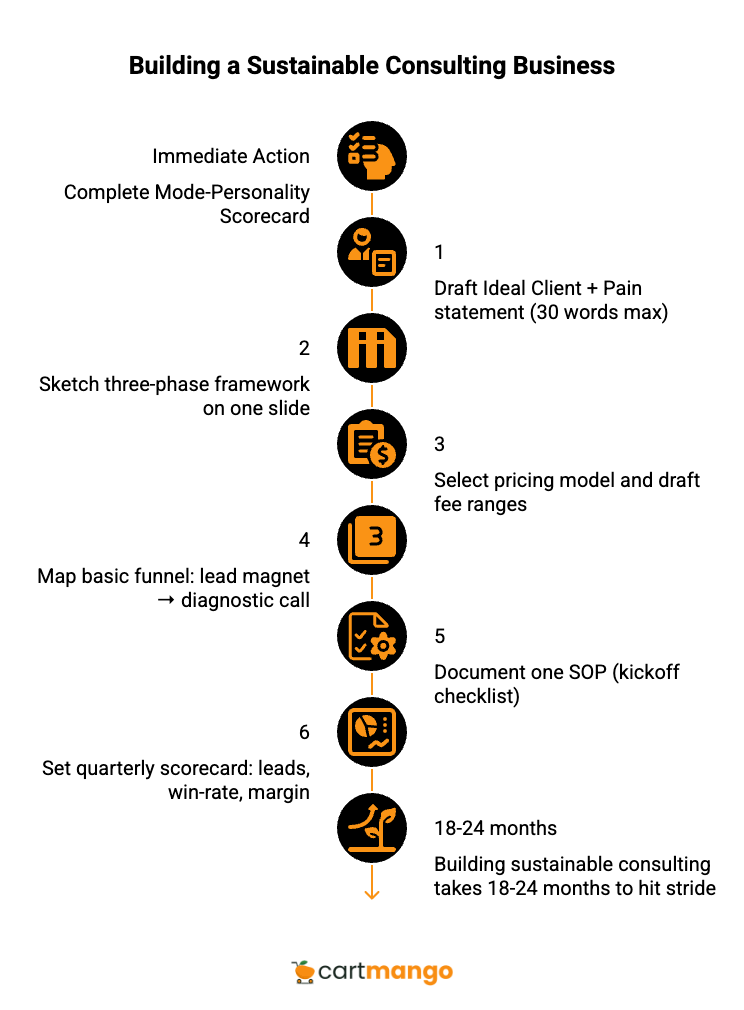
✔ | Immediate Action | Related Step |
|---|---|---|
Complete Mode-Personality Scorecard | Pre-step | |
Draft Ideal Client + Pain statement (30 words max) | 1 | |
Sketch three-phase framework on one slide | 2 | |
Select pricing model and draft fee ranges | 3 | |
Map basic funnel: lead magnet → diagnostic call | 4 | |
Document one SOP (kickoff checklist) | 5 | |
Set quarterly scorecard: leads, win-rate, margin | 6 |
Building sustainable consulting takes 18-24 months to hit stride. AI adoption is trimming delivery time though. McKinsey’s own AI tool, Lilli, helps consultants cut down the time they spend on research by 30% (Source: McKinsey).
A capacity-aligned model transforms feast-or-famine freelancing into predictable, scalable business. Pick one action and complete it this week. Small consistent steps beat grand plans that never start.
Which consulting business model will you build?
Related
- SendOwl vs SamCart: The Recurring Revenue Jail (2026)
- ThriveCart vs ClickFunnels: When more features hurt (2026)
- SendOwl vs Payhip: The “You-Leave-You-Lose” Model (2026)
- SamCart vs Kajabi: The Income Hostage Trap (2026)
- Sellfy vs Payhip: The Recurring Revenue Prison (2026)
- Podia vs Gumroad: The Recurring Revenue Handcuffs (2026)
- SendOwl vs Gumroad: The Recurring Revenue Black Hole (2026)
- Gumroad vs Sellfy: The Vendor Lock-in Cage (2026)
- Gumroad vs Payhip: The Hidden Trap for Creators (2026)
- ThriveCart vs SamCart – The Subscription Hostage Trap (2026)
